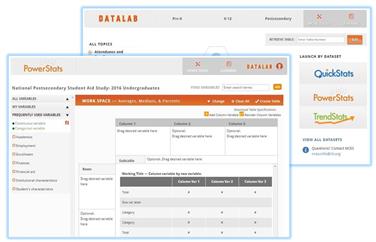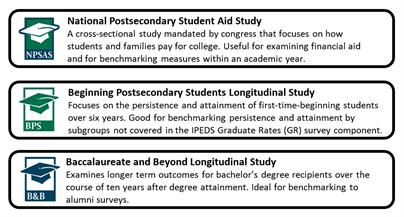New Data, New Possibilities: Benchmarking With NCES Sample Surveys
With the recent release of the 2015-16 National Postsecondary Student Aid Study (NPSAS:16) by the National Center for Education Statistics (NCES), a common question posed by institutional researchers—especially those who provided data for the survey—goes something like this: “What kinds of data are available with NPSAS, where can I access them, and how can I use the data to benefit my own institution?”
The Integrated Postsecondary Education Data System (IPEDS) is widely used within the IR community as a benchmarking tool to compare institutional measures such as enrollment and financial aid. Because the data are publicly available, measures are relatively stable over time, and peer institutions can be easily compared using the customizable Data Feedback Report, IPEDS is particularly useful for these purposes.
Benchmarking possibilities with IPEDS are, however, limited by the aggregate nature of the data and the definitions used to create those measures. In order to dig deeper and analyze more specific student subgroups, researchers will need to look for another data source.
The National Postsecondary Student Aid Study (NPSAS) is a cross-sectional sample survey designed to measure how students and their families pay for college. But in addition to its primary use as a tool for analyzing financial aid, it serves a secondary purpose of collecting comprehensive data on students and institutions on a wide variety of topics, many of which cannot be easily captured in IPEDS, such as remedial course taking, financial literacy, student disabilities, military veterans’ benefits, and student experiences. And because NPSAS collects a wealth of detailed demographic information, it provides researchers with the ability to examine measures of interest by demographic variables, which can be difficult using IPEDS.
Given these unique advantages, NPSAS is an ideal choice to address some of the limitations inherent with using IPEDS for benchmarking. While the nature of the NPSAS sampling design does not allow for comparison to specific institutions, the study does provide nationally representative estimates at the sector level for most measures, making benchmarking to institution sector possible.
Researchers can quickly and easily access NPSAS data and begin expanding their benchmarking using DataLab, an online suite of data tools that can be used to analyze various NCES datasets. DataLab comprises three separate programs: QuickStats, ideal for quick and simple calculations; PowerStats, designed for more sophisticated analyses including cross-tabulations, percentage distributions, averages, medians, linear regression, and logistic regression; and TrendStats, which can be used to examine changes over time using NPSAS data from 1996-2016.
benchmarking using DataLab, an online suite of data tools that can be used to analyze various NCES datasets. DataLab comprises three separate programs: QuickStats, ideal for quick and simple calculations; PowerStats, designed for more sophisticated analyses including cross-tabulations, percentage distributions, averages, medians, linear regression, and logistic regression; and TrendStats, which can be used to examine changes over time using NPSAS data from 1996-2016.
All three tools share an intuitive, drag-and-drop interface, providing analysts the flexibility to design customized tables that fit their needs. Users also have the ability to save their work in the platform, download a specification file to use later, or email codes or web links to automatically regenerate a table or regression output.
Because of its size and nationally representative design, NPSAS also provides an excellent opportunity to oversample certain groups of students that are of particular interest for longitudinal analysis, so most NPSAS administrations give rise to one of two related surveys: the Beginning Postsecondary Students Longitudinal Study (BPS), which focuses on the persistence and attainment of first-time-beginning students, and the Baccalaureate and Beyond Longitudinal Study (B&B), which examines longer term outcomes of bachelor’s degree recipients.
BPS and B&B datasets are also available in DataLab, and together with NPSAS, provide an array of additional benchmarking resources for institutional researchers.
To further expand the capabilities of NPSAS and provide another layer of comparison for institutional researchers, certain administrations of the study moving forward will feature state-representative estimates in addition to national data, including the 2017-18 National Postsecondary Student Aid Study, Administrative Collection (NPSAS:18-AC), currently underway.
Support for DataLab users is available through the Learning Center, which includes videos and step-by-step instructional materials, and from the DataLab help desk at (800) 677-6987 or nces.info@rti.org.
